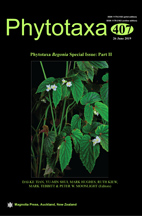Abstract
Begonia danxiaensis, a new tuberous species of Begonia, is described and illustrated, and supported by morphological and molecular evidences. It belongs to Begonia sect. Diploclinium and is endemic to the Danxia landforms of both Jiangxi and Hunan provinces, China. The morphological similarity between the new species and its similar taxa were compared and discussed. The new species is assigned to Vulnerable (VU) according to the IUCN Red List Categories and Criteria.

